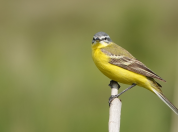Zoeken
Filteren op
Type
Labels
Dossiers
Thema's
Afdelingen
Taal
Active filters
1730 zoekresultaten
Zoekresultaten
-
Living Lab B7
Living Lab B7 wil de biodiversiteit in de Bollenstreek verbeteren. Dit doen we door inzichten over biodiversiteit te delen en ter plekke toe te passen. Co-creatie en kennisontwikkeling in de praktijk, samen met lokale partijen.
-
Research waste in ecology: urgent call for action
Only about 11 to 18 percent of ecological research reaches its full informative potential. Ignoring this problem is costly. The responsibility to solve it lies with funders, publishers, research institutions as well as with the researchers themselves.
-
Light on Nature
We produce more and more light at night. Virtually everybody in Europe or the US lives in a light polluted place: all areas where artificial light always exceeds the light of the moon and the stars. These areas expand with about two percent per year, while already light polluted areas become even brighter at night.
-
Licht op Natuur / Licht op Landschap
Het wordt steeds lichter 's nachts. Bijna iedereen in Europa en de VS woont op een plek die als 'lichtvervuild' kan worden aangemerkt: daar is is ons eigen licht altijd sterker dan het licht van de de maan en de sterren. Elk jaar neemt dat gebied met twee procent toe, terwijl de al lichte plaatsen nog lichter worden.
-
Soil transplantation
How can former arable fields be restored to nature? How can we turn a heavily managed soil into a species-rich grassland or heathland? And what is the role of soil organisms in steering plant communities?
-
Bodemtransplantatie
Natuurherstel van voormalige landbouwgrond, hoe gebeurt dat? Hoe maak je van zwaar bemeste bodem een schraal grasland of heideveld? Welke rol spelen bodemorganismen in het sturen van plantengemeenschappen?
-
IJkcentrum voor de Bodem
Een nieuwe faciliteit voor het vergelijken van de bodembiodiversiteit.
-
Climate Pursuit
A century of climate change, bringing ever higher temperatures. Life can be hard: what would you do to survive as a bird, plant or rodent? Try the new game Climate Pursuit to find out.
-
Climate Pursuit
Stijgende temperaturen, extremer weer en ook nog meer steden...er is een hoop aan de hand in onze veranderende wereld. In Climate Pursuit probeer je een eeuw te overleven door naar koelere gebieden in het noorden te trekken of via evolutie gunstige nieuwe eigenschappen te scoren. Ga jij het redden?
-
LTER-LIFE
LTER-LIFE is a Large-Scale Research Infrastructure in the making. It will provide a state-of-the-art e-infrastructure to study and predict how changes in climate and other human-induced pressures affect ecosystems and biodiversity. We have applied for funding in the Call for proposals for Large-scale Research Infrastructure – National Roadmap Consortia 2021 of the Netherlands Organisation for Scientific Research (NWO).
